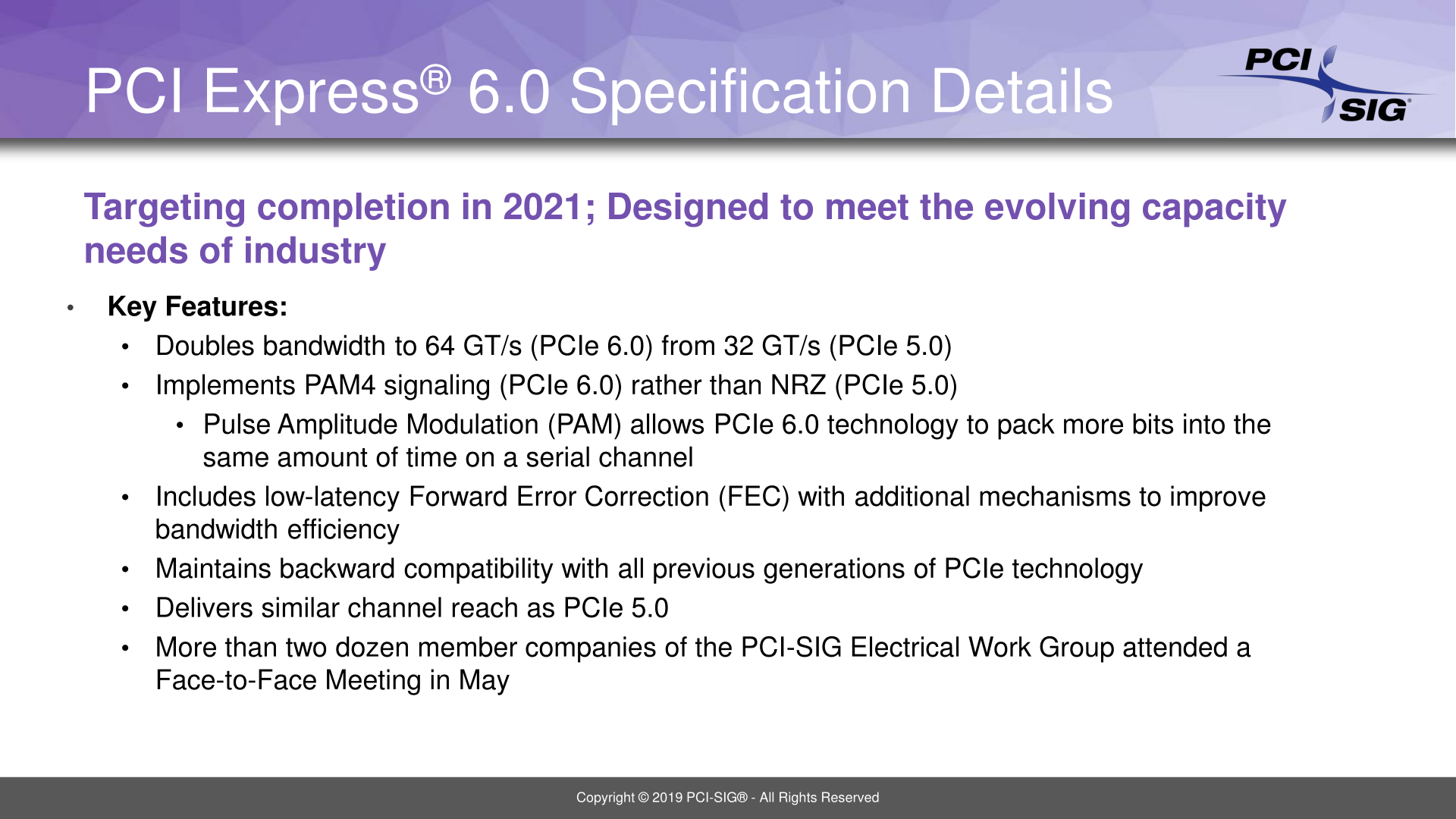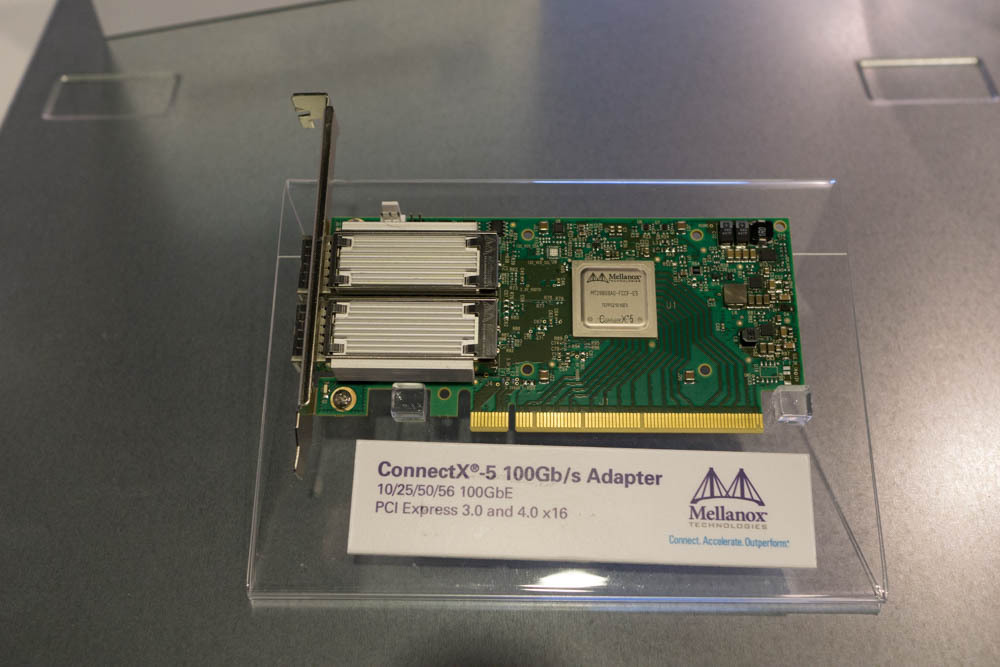
O Changed PCIe to PCI Express when discussing the PCI Express specification. O Cleaned up drawings in Figure 1-1 o Swapped order of section 1.3 and 1.4 and edited text o Fixed missing references. O Added signal switches suggestions for SATA and USB 3.0 March 21, 2011 Version 2.01. For now, PCI Express 4.0 is the fastest specification available for home computers. However, PCI Express 4.0 is only supported by AMD on its latest motherboards that are based on the X570 chipset paired with AMD Ryzen processors from the third generation. Unless you have these, there's no point in buying graphics cards or solid-state drives. The PCI-SIG announced that PCIe 4.0 specification is finished and plans to have PCIe 5.0 ready by 2019, which may cripple the 4.0 spec before it gets out of the gate.
The PCI-SIG has announced the completion of the PCIe 5.0 specification. In the history of PCI development, this may be the first time a new standard has been finished before the previous iteration had even launched in the consumer market.

“New data-intensive applications are driving demand for unprecedented levels of performance,” said Al Yanes, PCI-SIG Chairman and President. “Completing the PCIe 5.0 specification in 18 months is a major achievement, and it is due to the commitment of our members who worked diligently to evolve PCIe technology to meet the performance needs of the industry. The PCIe architecture will continue to stand as the defacto standard for high performance I/O for the foreseeable future.”
The rapid launch of PCIe 5.0 is the result of PCIe 4.0’s massive delay. PCIe 1.0 became available in 2003, followed by PCIe 2.0 in 2007 and PCIe 3.0 in 2010. (These are the dates when the standards were completed, not when motherboard hardware became available). PCIe 4.0, in contrast, wasn’t actually completed until 2017. The long delay in 4.0’s launch means that 5.0 will likely be deployed relatively quickly. As always, PCIe 5.0 will remain backward compatible with previous PCIe versions.
It’s not clear how the market will react to the quick appearance of PCIe 5.0 versus 4.0. AMD, for example, clearly intends to adopt PCIe 4.0 for its third-generation Ryzen platform, but could theoretically be planning a relatively quick migration to PCIe 5.0. Intel could theoretically planning for a fast shift to PCIe 5.0 — or the two standards might co-exist in market, with PCIe 4.0 used for less-demanding applications, while maximum performance markets push for PCIe 5.0. We haven’t seen PCIe 5.0 used as a differentiator this way before in client PCs, however, and for good reason — up until now, it’s never particularly mattered. While multi-GPU configuration performance can be impacted by PCIe lane availability, single-GPU performance has never scaled well against PCIe lanes, and I don’t recall any instance of a new GPU scaling better on a new version of PCIe at launch as compared to the immediately previous standard.
The delivery of the PCIe 4.0 specification to the industry is an important addition to our spec library as it delivers high performance 16GT/s data rates with flexible lane width configurations, while continuing to meet the industry’s requirements for low power. Additional functional enhancements include. The PCI Express 4.0 specification was finalized in October of 2017 with a published transfer (bit) rate of 16 GT/sec, double the bit rate of the previous version, PCIe 3.0. In the table below, you can see the aggregate bandwidth options offered by PCIe 3.0 vs PCIe 4.0.
The popularity of PCIe-based SSDs and the M.2 form factor, however, have changed things. While the gap between using an SSD and an HDD is still far larger than the improvements gained when moving from a standard SATA SSD to an M.2 drive, opening up the throttle on PCIe 5.0 will really give NAND and Optane room to stretch their collective legs. A PCIe 3.0 M.2 drive with an x4 connection provides up to 4GB/s of bandwidth in each direction. PCIe 4.0 doubles this to 8GB. PCIe 5.0 doubles it again, to 16GB.
Not only does this mean that even an x1 PCIe 5.0 link is now a heck of a lot more capable than it once was, it also means x4 drives are approaching theoretical transfer rates we used to associate with main memory not so long ago. This doesn’t actually mean NAND performs like RAM, of course. Neither Optane nor NAND are a replacement for DRAM in current client machines, and the latencies and sustained performance characteristics are entirely different. But the relatively quick jump from PCIe 3.0 to PCIe 5.0 means maximum storage performance could get substantially faster than it is already in a relatively short period of time.
The earliest we’d expect to see PCIe 5.0 adoption would be in 2020, and 2021 wouldn’t be crazy depending on how quickly Intel and AMD adopt the standard.
Now Read:
Some things are better late than never. At its yearly developers conference, PCI-SIG announced the PCI Express 4.0 specification to its members. As expected, the updated I/O technology will offer twice the bandwidth of PCIe 3.x while retaining full backwards compatibility.

Although it started as a key I/O component in PCs, PCIe now serves as the interconnect for any number of devices, including those in the server, storage, and mobile markets. The full details of the new specification haven't yet been published on the consortium's website, but we're told that it doubles the per-pin bandwidth of the previous generation, offering 16 GT/s data rates.
Given PCIe's wide variety of use cases, PCI-SIG also decided to improve the interconnect's flexibility and scalability. Developers will have access to more lane width configurations and speeds suitable for low-power applications. Other enhancements include reductions to system latency, improved scalability for added lanes, and lane margining.
PCI-SIG also teased the upcoming PCIe 5.0 specification. Penciled in for 2019, PCIe 5.0 will push the available bandwidth to 32 GT/s. One application that the consortium has in mind is high-end networking, where the architecture can serve up 128 GB/s of bandwidth operating at full duplex.

Pcie 4.0 Specs
The PCIe 4.0 specification still needs to undergo a final IP review, but the PCI-SIG claims that the interconnect is ready to go. Prior to the publication of the spec, the SIG had already been doing compliance testing with a variety of its members, and it claims that a number of 16 GT/s solutions have already been worked out. Perhaps we'll see products using the new spec make their way to shelves sooner than later.